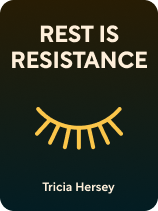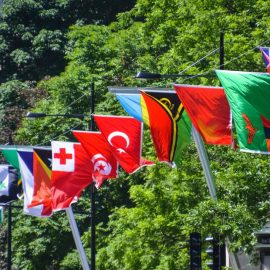

This article is an excerpt from the Shortform book guide to "Rest Is Resistance" by Tricia Hersey. Shortform has the world's best summaries and analyses of books you should be reading.
Like this article? Sign up for a free trial here.
Is your work-life balance out of whack? Have you forgotten how to truly rest and enjoy leisure time?
The live-to-work mentality has become deeply ingrained in our society, warping our relationship with rest and leisure. Many people find themselves unable to stop working, either because they’ve forgotten how to relax or believe they don’t deserve a break.
Keep reading to explore three myths behind this toxic belief system that Tricia Hersey identifies in her book Rest Is Resistance.
The Live-to-Work Mentality
Hersey says that modern society indoctrinates people into believing that work is their primary reason for existing. This pervasive “live-to-work” mentality, deeply ingrained by grind culture, has warped our relationship with rest and leisure. As a result, many individuals find themselves unable to truly rest—either because they’ve forgotten how, they believe they don’t deserve it, or they don’t think they can afford to stop working even briefly.
(Shortform note: The live-to-work mentality that Hersey describes is not only a feature of modern society, nor is it exclusive to the US. In Meditations, one of the foundational texts of Stoicism, Roman emperor Marcus Aurelius promotes a similar mindset: Aurelius says that people who find meaningful work to do won’t want to do anything else. He says that such people will work themselves to exhaustion, rest only as long as they absolutely need to, and then continue working. Aurelius adds that people who don’t work in this fashion must not have enough love for themselves nor enough passion for what they do.)
Three myths form the foundation of this toxic belief system.
Myth #1: People’s Value Comes From Their Work
Grind culture teaches that people’s value comes solely from what they do, and is measured by their productivity, achievements, and wealth. Therefore, in order to prove their worth, people must orient their entire lives around labor.
However, Hersey says that this belief is fundamentally flawed and harmful. Obsessing about productivity drives people to exhaustion, as well as creating pervasive feelings of guilt and shame because people believe they’re not doing enough. She therefore rebuts this idea, saying that our worth as human beings is inherent, and not contingent on productivity or career success.
(Shortform note: In The Courage to Be Happy, the authors—drawing from the work of psychiatrist Alfred Adler—say that the key to happiness is to feel valuable, and that you feel valuable when you make yourself useful to others. While this seems to echo grind culture ideology, the authors add that being useful to others doesn’t always mean concrete acts like working for them. Instead, Adler taught that you can improve people’s lives merely by living and participating in your community. For instance, if you meet a friend at the bar and have an enjoyable conversation, you’ve been useful by making your friend a bit happier. According to Adler, by doing so, you’ve boosted your value in a way that has nothing to do with work.)
Myth #2: Rest Is a Luxury
The second myth grind culture pushes on us is that rest is a luxury, and therefore it’s reserved only for those who can afford to take a break from working. This mindset often leads people to view rest as a privilege they must earn through hard work or financial success.
Hersey says that, in reality, rest is a fundamental human need and should be a priority for everyone, regardless of their social or economic status. Rest is not a luxury or an indulgence; it is an essential component of a healthy, balanced life.
With that said, it’s true that people need money to survive under capitalism—many people literally can’t afford to stop working and get the rest they need. This is why Hersey argues that rest must be a communal priority as well as an individual one, so that people can support each other in their efforts to heal from grind culture.
(Shortform note: As Hersey says, rest is a fundamental human need. One reason is that a lack of good-quality rest can lead to burnout. Though it’s often conflated with simple fatigue, burnout is a serious health condition with symptoms including anxiety, insomnia, heart palpitations, and the inability to make even simple decisions. Also note that recovering from burnout often takes much longer than people think—severe cases can require up to a year of rest. Furthermore, forcing yourself to work despite being burned out can cause further mental, emotional, and even physical harm, up to and including death.)
Myth #3: We Must Compete for Scarce Resources
The third myth of grind culture is that there aren’t enough resources (money, food, property, and so on) for everyone. Therefore, according to grind culture, we must all ruthlessly compete for these scarce resources, and hoard as much as we’re able to get.
Hersey argues that this individualistic worldview overlooks the ways people are connected. Humans are inherently social creatures; we evolved to live and thrive in groups. Therefore, people’s physical and emotional well-being depend on connection and cooperation.
(Shortform note: As neuroscientist Robert Sapolsky explains in Behave, the human drive to live and work with others goes back to the earliest days of human civilization. Our ancient ancestors lived in hunter-gatherer societies that required everyone to cooperate in order to survive and thrive; as a result, humanity evolved to want to help each other. This is a likely root cause for what folk wisdom and scientific studies alike have observed: Being kind and generous to others makes you happier than selfishly hoarding wealth does.)
Hersey also says the truth is that the world is abundant, meaning there are more than enough resources to meet everyone’s needs as long as we share them fairly. The only reason people suffer from issues like hunger and homelessness is because grind culture indoctrinates us to be selfish, instead of sharing the world’s wealth equitably.
Hersey adds that many forms of scarcity are artificially created or exacerbated by systemic issues, rather than by true physical limitations. For example, housing and diamonds are both artificially scarce (and therefore artificially expensive) because large corporations control much of the world’s supply.
(Shortform note: The housing crisis in the US is an example of the artificial scarcity Hersey describes. In 2023, Senate Democrats argued that the lack of affordable housing is being driven, in large part, by corporate investors who buy up thousands of homes and convert them into overpriced rental properties. Would-be homebuyers don’t have the money to compete with these wealthy corporations, and therefore they find themselves locked out of the housing market.)
| Just How Abundant Are Earth’s Resources? Hersey asserts that Earth has more than enough resources for everyone, and the problem is only in how we’re using those resources. Exactly how many people the world can support is a matter of ongoing debate in the scientific community, but most estimates agree that there are enough resources to support at least the current population. In Lifespan, biologist David Sinclair says that current estimates of Earth’s maximum population range anywhere from eight billion (which we’ve already surpassed) to 16 billion people. However, Sinclair also points out that technology will continue to advance, and civilization will be able to support more and more people as a result. In fact, Sinclair questions the assumption that there even is a maximum population. He argues that overpopulation concerns have been around for many years. However, the last two centuries (since the Industrial Revolution) have seen the global population grow exponentially; at the same time, the average quality of life has improved more quickly than at any other period in history. He sees no reason why that trend should suddenly reverse itself now, leading to poverty and suffering if the population continues to increase. |

———End of Preview———
Like what you just read? Read the rest of the world's best book summary and analysis of Tricia Hersey's "Rest Is Resistance" at Shortform.
Here's what you'll find in our full Rest Is Resistance summary:
- How modern grind culture hurts you physically and spiritually
- The 3 myths that grind culture instill in society
- How rest can be used as a radical form of resistance






